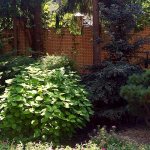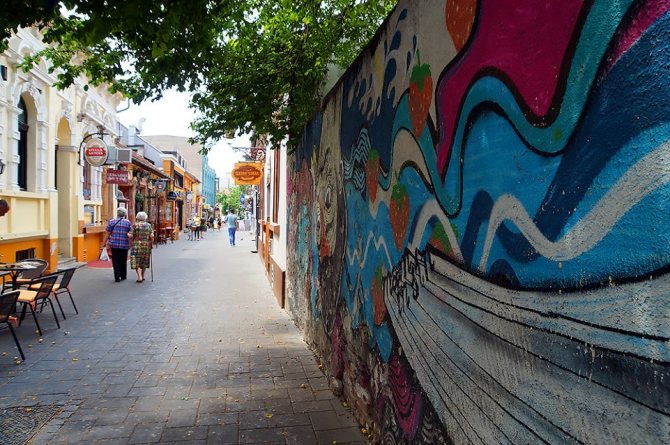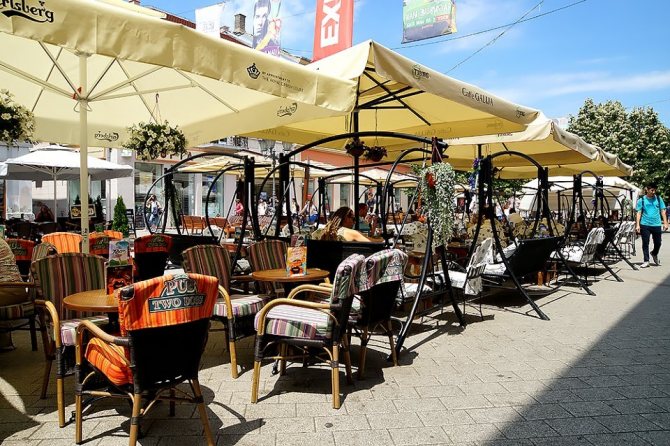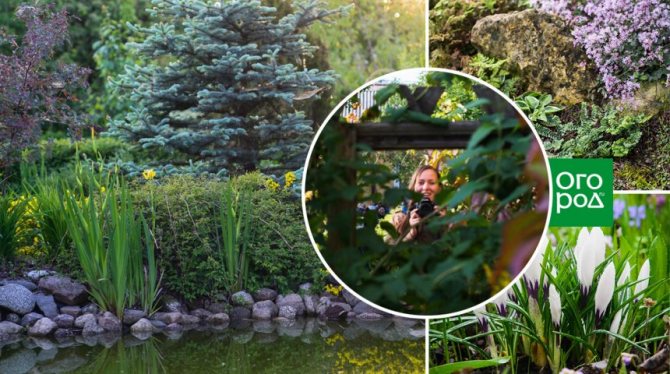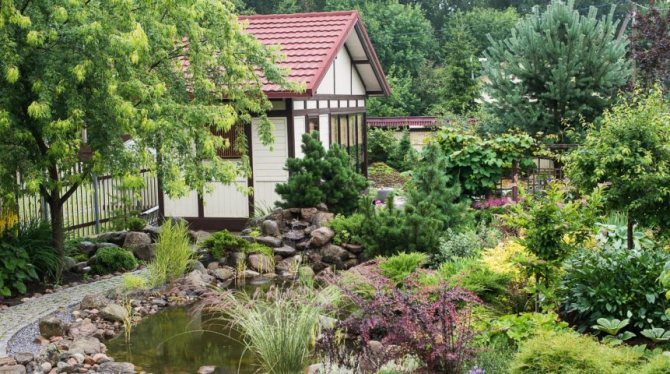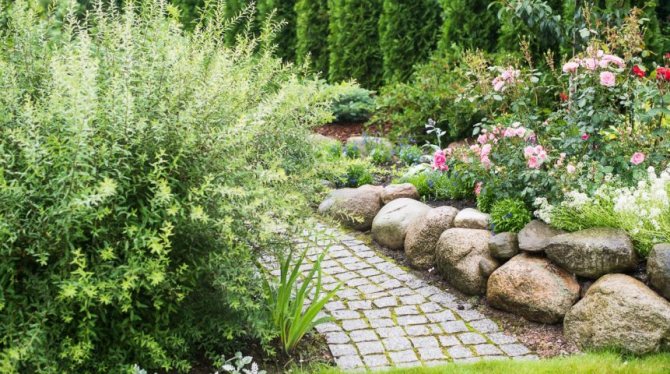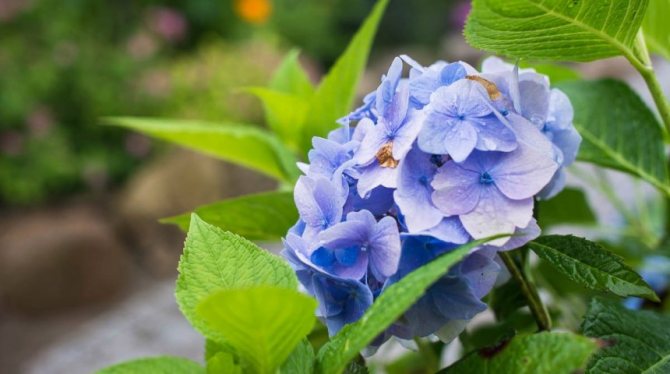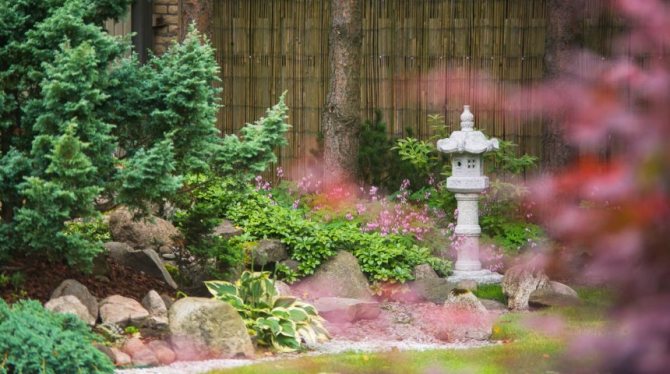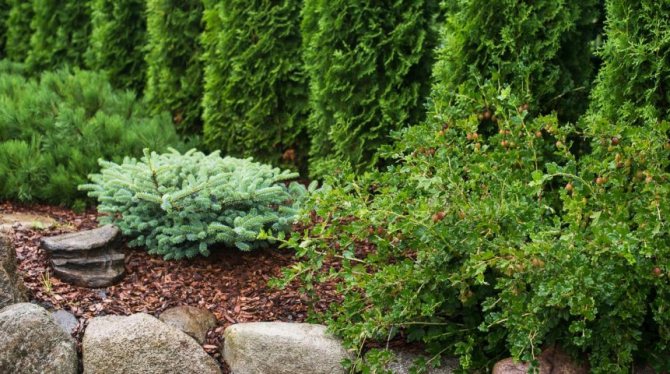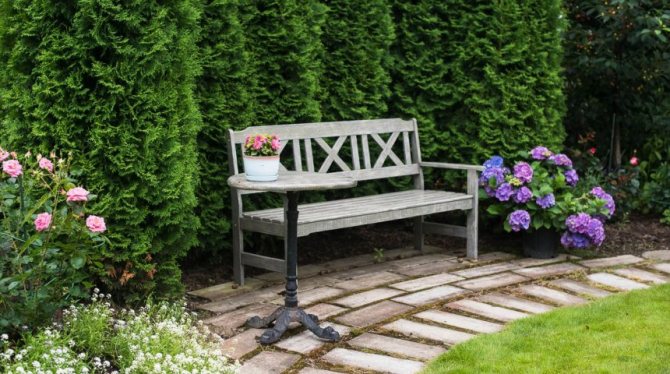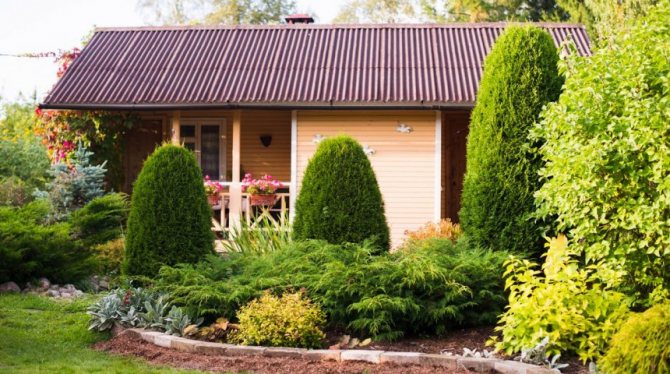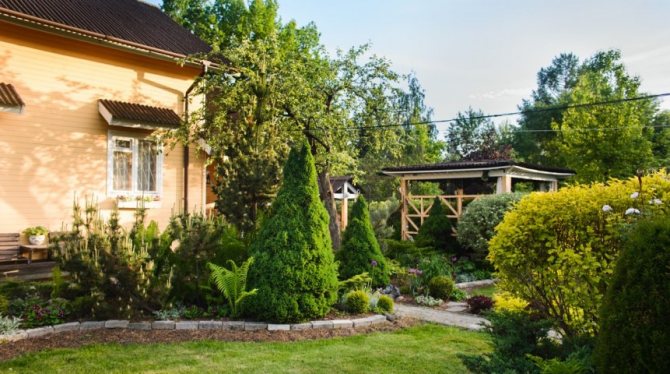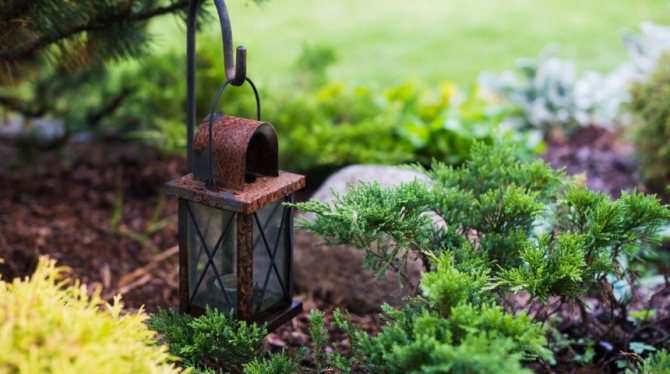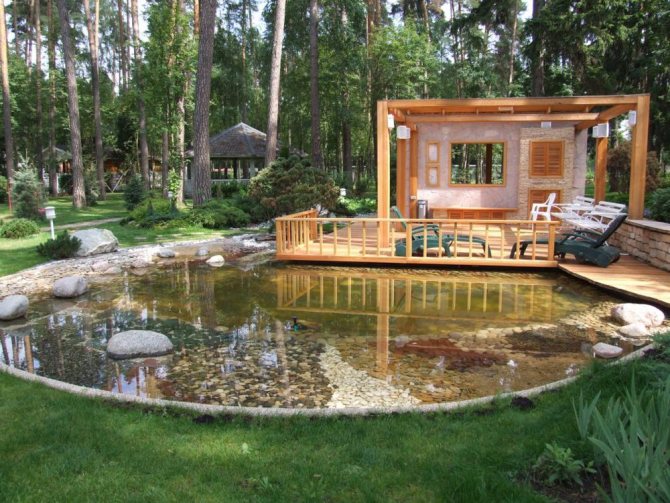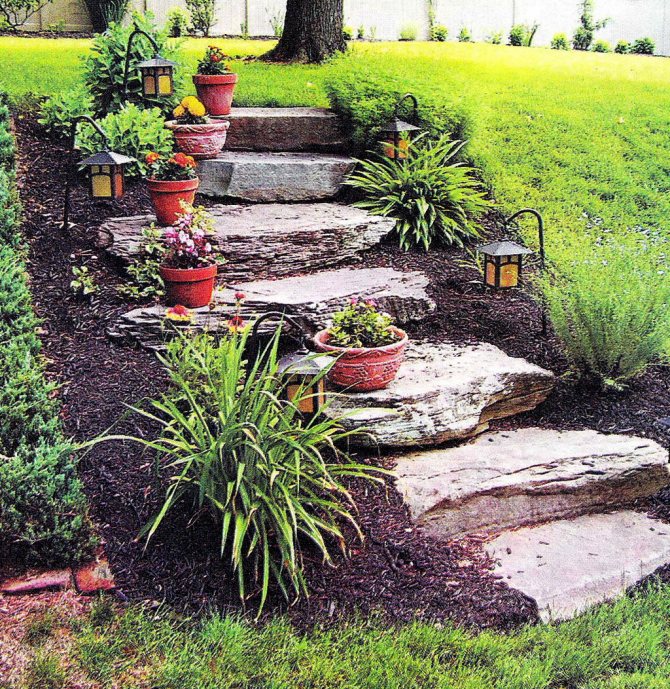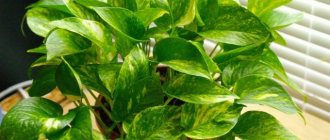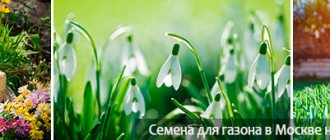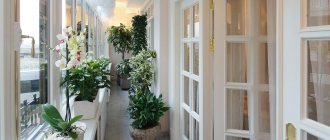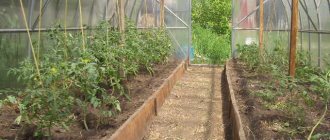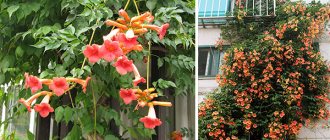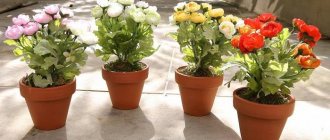In developing the design, we tried to create a space in which the owner would be comfortable, convenient and joyful at any time of the year. The concept of this garden is harmony, simplicity, ease of use and maintenance. The style was set by the existing architectural structures and the forest, which occupies the lion's share of the site. We wanted to obtain a harmonious picture with the maximum preservation of natural plantations and create the middle and lower tiers of the undergrowth.
Development of a new site: laying a garden
The garden is quite young - it is 14 years old, we have already purchased it with a small number of fruit and ornamental trees planted by the first owners of the garden. The central part of the garden was almost empty, so there was nowhere to hide from the sun. Having moved there in the spring at the beginning of the season, we started by clearing the site of debris. The old, once planted lawn is overgrown with weeds and meadow grasses. We began to mow the grass often, and the weeds stopped growing over time, so we put the lawn in order.

The first trees planted were dug out of the nearby forests: pine, spruce, hazel, bubblegum. Spruce and pine trees from the forest were planted along the edges of the site, and forest junipers were planted closer to the house, without even thinking that over time they would grow strongly, the desire was to shade the garden and hide from prying eyes. Then I made sure it was done correctly. We have very strong winds, and conifers perfectly protect the garden from the wind. Five years later, the plantings began to grow, and I began to pinch forest pines. Of course, they are far from nivaki, but the koloboks from them turned out to be even very cute and compact.
Lawn size and shape
Another important note is that the size and shape of the lawn must be carefully thought out and calculated. Designed to fit the width of the mower without sharp corners. Then you do not have to go through with the lawn mower once again or cut the "inconvenience" additionally using scissors. A lawn mower is better than a petrol one and, of course, with a grass catcher.
And don't put lanterns on the lawn! It is very inconvenient to mow them.
Dear Readers! I hope that my advice, gained by my own experience, will be useful to you. And even if you do not make some of the mistakes when creating your garden, it means that I did not write this article in vain.
Choosing plants for a natural style garden
Then came the passion for varietal conifers. I picked up neighbors who get along with them on acidic sandy loam soil: azaleas, rhododendrons, magnolias, large-leaved and paniculate hydrangeas. I, like all novice gardeners, wanted to embrace the immensity.
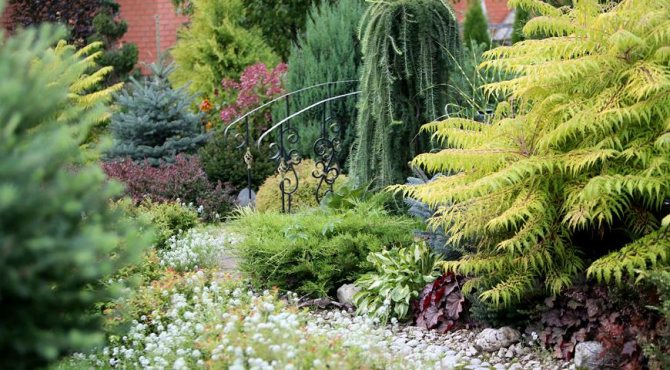

The garden is dominated by conifers, they are given the most honorable place. They are accompanied by various varieties of barberries, spireas, boxwoods, deer-horned sumacs, euonymus, azaleas, rhododendrons, magnolias, vesicles, mahonia, kerria, kalmias, more than 20 varieties of paniculate and large-leaved hydrangeas.
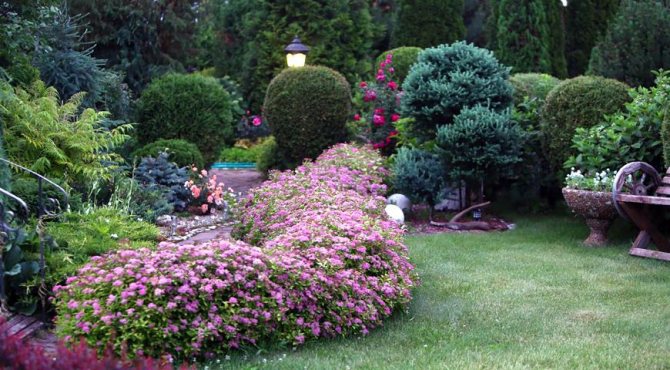

In the spring, during the growing season of conifers, the garden looks unusually spectacular. When young growths appear on spruces and pines, for these two weeks in the garden they become real kings and queens of the garden due to red, yellow, pink, white, shoots and unusually beautiful purple cones on firs. Further blooming azaleas, rhododendrons, magnolias, lilacs.
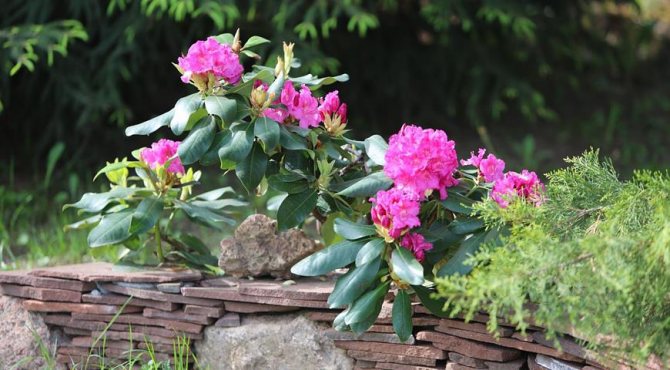

The main decoration of the garden in the summer is hydrangeas, from various panicle varieties to large-leaved colored ones. To achieve the annual flowering of large-leaved hydrangeas, which froze every year and had to wait a long time for them to bloom again, I arranged for them to winter in the basement, creating special conditions there.
And it paid off. Now hydrangeas bloom every year, delighting us since May, no matter what the winter was.
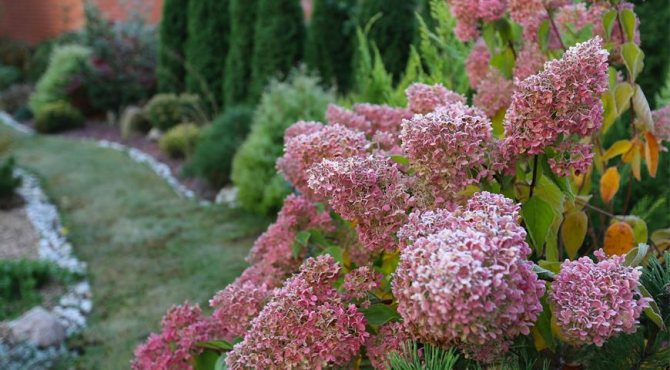

Autumn is a special time when all deciduous trees come on the stage, arranging such a riot of colors that even in summer, when everything is in bloom, you cannot see this. This is an unforgettable time where the colors of the shrubs change every day.
Winter is the time of my favorite conifers, when the whole geometry of the garden is revealed. Sheared balls of thujas, wicker willows, pyramidal thujas Smaragd, spiral sheared thujas, weeping willows and larch trees on a trunk transform the garden and make it attractive even in winter. Thus, the garden remains decorative all seasons.
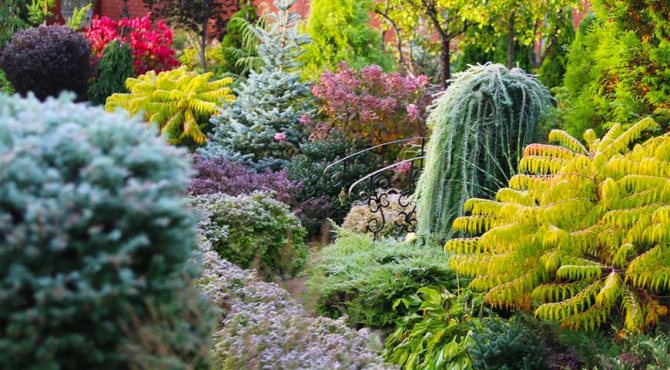

Now, due to climate change, our winters have become milder, and gardeners have the opportunity to grow more thermophilic plants, which we could not even dream of before. For example, this year I ventured to plant bamboo (fargesia), which can withstand short-term frosts down to -25 ° C. I hope that over time it will acclimatize in our conditions, like many other more southern plants that already grow in our garden.
I buy plants only with a closed root system and plant before the first frost, all the seedlings in the first year must be covered for the winter.
For each soil, you need to approach with the selection of plants individually. What grows on sandy loam soil will not always grow on loam, and vice versa, so the correct selection of plants is very important here. When planting plants in sandy loam soil, it is very important to mulch the plants both to retain moisture and to keep the top layer of fertile soil from erosion.


In my garden, almost all plantings are mulched with geotextiles with decorative chips or gravel bedding. I do it this way: I mark the desired piece of land and cover it with spunbond along with the grass. The grass is overheated after 2 months, but you can immediately cut through the pockets and plant the plants.
So I save myself from unnecessary work on removing sod, digging up the earth and preserving the upper fertile layer of the imported land.
Design solutions in a natural style garden
Initially, the garden was a collection garden, but having collected more than 150 species of conifers, I realized that the collection garden was simply not interesting and boring, and started planning mixed plantings. I am more and more fond of landscape design, combining plants into compositions, where conifers still remain the leaders.
I began to study the compatibility of different groups of plants; here I was helped by various printed publications, magazines, and a selection of video programs ("Landscape Tricks" and many others); favorite amateur gardens appeared. So I began to create various landscape corners with a garden, adhering to the same style, but bringing my own personality to each corner. To make the garden interesting for the whole family, the decorative part was placed in front of the house, and the household with a bathhouse, swimming pool, greenhouse and orchard behind the house.


There is a lot of stone in the garden, which we brought from different places where we rested. All small architectural forms are made by hand. I really love working with stone, and most of the buildings in the garden are made of stone, tree roots and forged elements - arches, wells, fences, retaining walls and other decorative structures.
I really like Chinese gardens with their natural harmony. I used some elements in the garden. I tried to make a gazebo in the Chinese style with the help of my husband, I myself made frames for the gazebo with monolithic polycarbonate.In the past, it was an ordinary rag tent, which we converted into a stationary gazebo. On both sides of the gazebo, ponds were dug: one small with a waterfall, a path with a forged bridge leads to it, and the other is a pond for wintering koi carp and ornamental crucian carp. I have been doing this recreation area for 3 years. Since the site was absolutely flat, with the help of geoplastics I changed the relief of the site. It started with small alpine hills and embankments, retaining walls, artificial reservoirs, of which we have 4 on the site, each has its own purpose. A technical pond - for watering plants, the deepest pond - for wintering koi carp and decorative crucian carp, a mini-pond with a waterfall and a pond in a natural style.


Each contains nymphs and other aquatic and coastal plants.
So that the garden does not lose its decorative effect in the winter season, a network of stationary lighting was laid both in front of the house, where all decorative corners and a pond are illuminated, and behind the house, so that in the dark, especially in winter, it was comfortable to be in the garden.


Features of caring for a site in the shade
One of our fundamental approaches is sustainability. We have been using the biological product "nemabakt" for the protection of plants from pests for 15 years. It is very effective, safe and economical, with prolonged action. Not only protects against pests, but also increases plant resistance to various diseases, improves survival rate, decorative appearance, promotes intensive growth. The need for the use of chemicals - fertilizers and growth stimulants - is significantly reduced. In this area, the drug is used regularly - once a year (a feature of the forest area), which made it possible to preserve almost 99% of the available trees in the midst of bark beetle infestation in 2015-2017.
The most important thing where it all starts, including in landscape design, is the idea of a harmonious and healthy space, which results in the creation of a garden or park. It is important to be aware of it not only at the time of creating a design concept, but also throughout the entire process of work - when selecting plants, their survival rate, resistance to diseases and pests.
I wish you faith that everything around us is only good and contributes to successful growth and development.
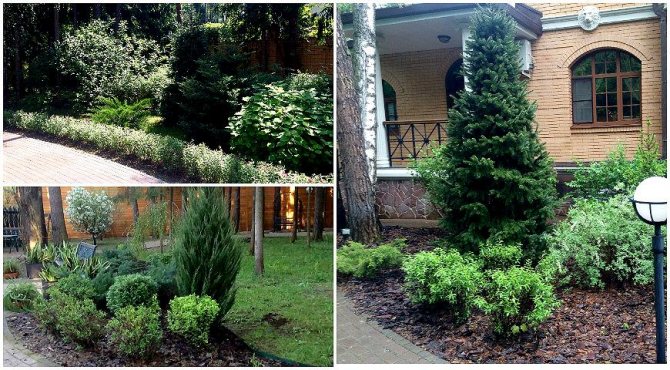

The main areas of the garden in a natural style
Since we have five children, the very first building in the center of the site was a playground with a lonely growing blue spruce, planted by the previous owners.
To zone the playground, thujas Globosa and Globosa Viridis were planted around it, the area was separated from the road to the garage with thujas Brabant on both sides, and thujas Smaragd from the neighbors. When they closed, they formed a hedge to protect the garden from the scorching sun in summer and from the icy wind and prying eyes in winter.
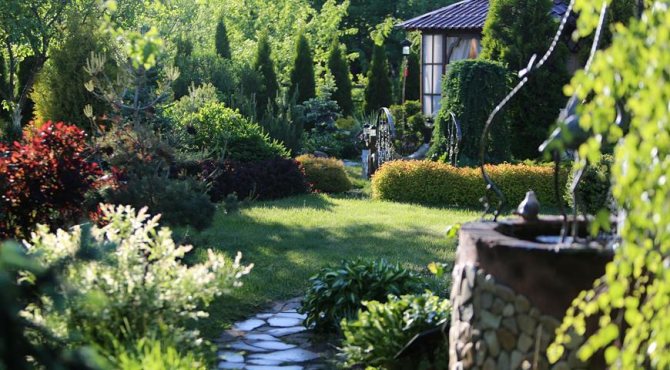

Gradually, they began to lay paths to the central part of the garden, to various secluded corners, where ponds, slides, bird canteens and much more open at every turn.
When the children were young, these were corners with various fairy-tale characters; some of them still remain in the garden as a reminder of childhood.
Children grew up, the garden changed and grew up with them, soon a playground with a slide was replaced by a cozy gazebo for the whole family.
Site functionality
The first thing we should take care of when creating a low-maintenance garden is the functionality of the site. You need to think over everything to the smallest detail, because everyday inconveniences cause so much trouble that all the pleasure of being in the country, in the garden will be spoiled by these very troubles.
I will list the points, the importance of which is somehow underestimated by the owners of the sites:
- The presence of a compost. And if the plot is large in area, then composting boxes should be arranged in different parts of the garden. It is extremely inconvenient and time consuming to dispose of plant residues if there is nowhere to compost them.
- A container for water, in my opinion, is a must. Another thing is how it will look and where it will be located, but this is a topic for a separate article.
- Household entrance will help save nerves and money, although it will take away some area from the garden. But when you need to bring sand, boards or something else, you will appreciate this convenience.
- Inventory storage should be organized so that tools are easy to pick up and quickly find.
- And even a place for drying clothes - think in advance where it is best to place it.


If the plot is large in area, then composting boxes should be arranged in different parts of the garden. <>
Plans and dreams
Garden maintenance is all year round, but there are many different garden maintenance tools on the market today.
The main technique that makes gardening and weed control easier is mulching. If they appear, then there are very few of them and they are easily removed. The garden is open to the public this year; there were many pleasant meetings, communication with novice gardeners and professionals. After such meetings, you can learn a lot and share your experience with others.
Next year, my husband and I are planning to build a large open veranda next to the house, where it will be possible to receive guests and gather with the whole family.
In winter, there is less work in the garden and there will be time to think about a project.
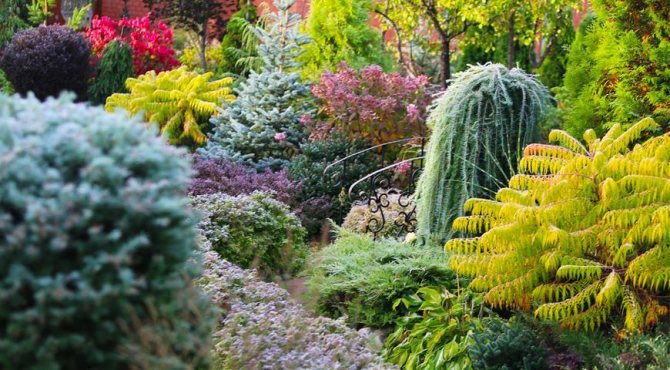

A garden is a constant movement and creativity, where there are no complete pictures, something always changes and time makes its own changes, sometimes even beyond our control. Having your own garden is an old dream that we have been pursuing for many years. Having realized this dream, you become a truly happy person, especially when you see the result of many years of work and the gratitude of plants that will delight us, our children and many lovers of beautiful gardens for many years to come.
Road and path network
The second thing you need to pay attention to is a convenient road and path network. Everyone knows that after the construction of a house and other buildings, you need to make paths on the site and make them efficiently. But in practice, it is ill-conceived paths that lead to the fact that movement around the garden becomes inconvenient and complicates the care of it.
- You cannot save on the width of the paths, especially in the garden area. If it is impossible to use a garden wheelbarrow, or to walk calmly with a bucket in hand, then what is the convenience here?
- Docks and intersections of tracks should be without sharp corners - this is a must! If you do not widen the site at the intersection of the paths, then the lawn will probably be trampled or the flowers will be broken, because a person will step into this place, because we always round the corners when moving.
- Tile layout - no cross-like intersections, this is especially important on heaving grounds.
- Choose a tile without a chamfer, such a track is difficult to keep clean, and this, you yourself understand, does not help to minimize maintenance.


You cannot save on the width of the paths, if it is impossible to use a garden wheelbarrow, or walk calmly with a bucket in hand, then what is the convenience here? <>

